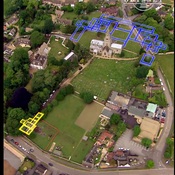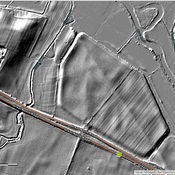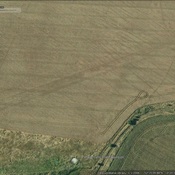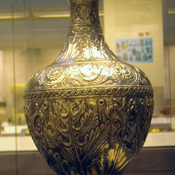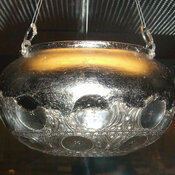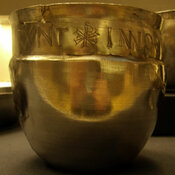A Roman camp of a size sufficient to house half a legion lies on the south bank of the River Nene at Longthorpe near Peterborough, in Cambridgeshire. The fortress probably housed five cohorts of Legio IX Hispana, very likely together with a force of auxiliary cavalry.
The original fortress measured 1,150 feet NW-SE by 950 feet NE-SW (350 x 290 metres) within the ramparts, which were fronted on all sides by a double ditch system and enclosed an area of almost exactly 25 acres (c. 10ha); enough room to comfortably house half a legion. The gateways of this large fort were centrally placed in the NE and SW sides, but on the NW and SE sides were off-set markedly towards the south-west by a ratio of 3:2; on this evidence it would appear that the fortress faced north-east.
The fortress may have been built as early as c.A.D.44, prior to the campaign against the Coritani of Lincolnshire. It is probable however, that the fortress was built in response to the uprising of the Iceni c.A.D.48. That the fortress was not in existence at the beginning of the revolt is possibly substantiated by the fact that the revolt was suppressed by the use of auxiliary forces only, implying perhaps that there were no legionary forces nearby.
The reduced fortress measured approximately 660 feet NW-SE by 725 feet NE-SW (c.200 x 220 metres), enclosing an area of approximately 11 acres (c.4.45ha) with a single ditch on all sides but the south-east where part of the original defences were utilized, the original gateway on this side being retained while a simple narrow gateway pierced the new north-eastern rampart. The ditch of the smaller fort measures about 10-11 ft (c.3.2m) wide.
The Roman historian Cornelius Tacitus (Annals; XIV.32) narrates how, during the initial stages of the revolt of Boudicca in the winter of AD60/61, a detachment of the Ninth Legion under the command of Quintus Petilius Cerialis was severely mauled by the rampaging Britons, the infantry was annihilated and the legionary legate escaped "back to the camp" with only his cavalry intact. Excavations carried out on the Longthorpe site by Sheppard Frere revealed that the defences of the fortress had been reduced in size to that of a large auxiliary fort, and that the work was carried out in a hurried fashion at around this period in history. It seems reasonable to assume therefore, that the "camp" to which Cerialis' cavalry escaped was in fact, the Longthorpe vexillation fortress1.

